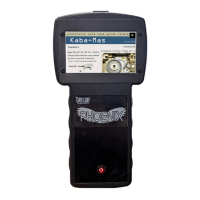18
Step 4] Inject IONIC Solution
Remove the protective cap from the IONIC
Solution ‘P’ and place the included needle onto
the syringe. Guide the needle down the spindle
hole and carefully insert it into the 3/32”
access hole. Once fully inserted depress the
plunger on the spiking solution and inject
approximately 3mL of solution into the lock case
then carefully remove the syringe and allow the
IONIC solution 3 or 4 minutes to coat the circuit board and start working its magic.
During this time the Phoenix will be sending a low level signal into the lock and taking
continuous readings to determine when the IONIC solution has successfully reached
the motor driver. After a few minutes the Phoenix may prompt you to inject additional
spike solution. This is entirely optional and you may decide for yourself when to add
more IONIC solution. To conserve spiking solution you may want to wait up to 10
minutes before adding more solution ‘P’. If you are feeling impatient you can also
“force” the issue by injecting 5mL initially and following up every 30 seconds with
another 1mL of solution. This will often allow a viable spiking connection to be made in
seconds rather than minutes.
Step 5] Spike Lock to Open
Once conductive contact with motor driver is clearly sufficient for spiking, the Phoenix
will indicate “Connection Found - Tap to Spike”. Tap the screen and the Phoenix will
show “Working…” then “LOCK OPEN” once the lock is successfully spiked. The tool will
show a countdown to indicate how much longer it will be holding the lock open. After
this expires the Phoenix will release the motor driver for a period to prevent any
potential damage to the circuit board. You can tap the following screen showing
“LOCK CLOSE - Tap to retry” to have the Phoenix again spike the motor driver and
open the lock. If the lock does not open on the first attempt then wait several minutes
and try spiking open again. Repeatedly trying to spike the lock open without allowing a
sufficient amount of “cooldown” time between attempts can reduce the effectiveness
of the IONIC solution already inside the lock case. As electricity travels through the
IONIC carrier solution hydrogen atoms are slowly released at the point of contact with
the motor driver and this can create small gas bubbles that push the solution away
from the driver contacts. If this occurs, injecting additional spike solution will “flush out”
the depleted solution and re-establish contact with the surface of the motor driver.

